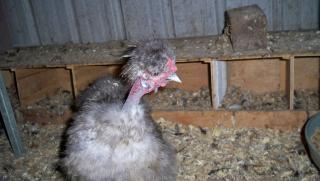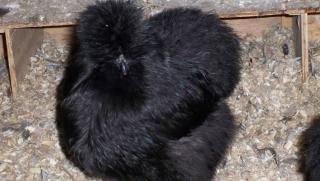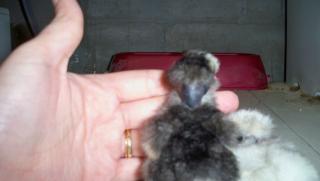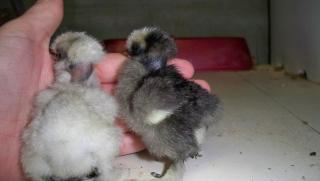I have 12 cuckoo silkie eggs in the bator. On day 6 so far out of the 12 I see 9 developing. I bought these eggs from a breeder from ebay who got his from a BYC member now sure who it was I'd have to look it up again. He has three cuckoo hens cuckoo cock and 1 cuckoo split black pullet in this pen. He said the skin was dark to a white coloring. I plan on breeding these back to my nice blacks with great crest and foot feathering and black skin. Whats my chances of the OS from my nice blacks to these cuckoo coming out with darker skin?
Navigation
Install the app
How to install the app on iOS
Follow along with the video below to see how to install our site as a web app on your home screen.
Note: This feature may not be available in some browsers.
More options
You are using an out of date browser. It may not display this or other websites correctly.
You should upgrade or use an alternative browser.
You should upgrade or use an alternative browser.
Cuckoo silkie questions for silkie color Guru's :)
- Thread starter Teresaann24
- Start date
breeding black to cuckoo will darken the skin. however as the bird matures the skin will sometimes lighten up here are some pics I bred this roo

to this hen

and found this in my bator this morning


the skin on this baby is darker than the light colored baby for now but may lighten up over time

to this hen

and found this in my bator this morning


the skin on this baby is darker than the light colored baby for now but may lighten up over time
cuckoo and pink skin gose together it hard get good dark skin and bared
the color and skin pigment are linked together
yes it is but I like pushing boulders up steep hills and beating my head against the wall




Quote:
i knew u knw but didnt know if Teresaann24
did
i knew u knw but didnt know if Teresaann24
did

Quote:
Hi! I don't think there is such-a-thing as 'cuckoo split black'. They are either have the barring gene and are barred (cuckoo) or not.
Hi! I don't think there is such-a-thing as 'cuckoo split black'. They are either have the barring gene and are barred (cuckoo) or not.
I bred this roo

to this hen

and found this in my bator this morning


the skin on this baby is darker than the light colored baby for now but may lighten up over time
Precious, precious, precious!!!!
I don't see any head-spot indicating the chicks inherited barring.

Lisa

to this hen

and found this in my bator this morning


the skin on this baby is darker than the light colored baby for now but may lighten up over time
Precious, precious, precious!!!!
I don't see any head-spot indicating the chicks inherited barring.

Lisa
Quote:
There isn't - and the way its stated above would indicate that the bird is "cuckoo split to black", which isn't possible to my knowledge. If being "split to cuckoo" were possible, the term would be "black split to cuckoo", not the other way around. Sometimes a "/" is used to indicate a split as well, and in this case it would be "black/cuckoo". But being split to cuckoo isn't possible, so forget what I just said....

Here's the deal: Barring is dominant - if you can't see it, it isn't there. Barring also affects skin/comb/wattle color and it is very difficult to get dark skin/comb/wattles with this gene. Roosters can be single or double factor barred - hens can only be single factor - here are the scenarios:
Single factor barred rooster x non-barred hen = single factor barred and non-barred offspring of both sexes
Single factor barred rooster x barred hen = single and double factor barred males, barred and non-barred females
Double factor barred rooster x non-barred hen = single factor barred offspring of both sexes
Double factor barred rooster x barred hen = double factor barred males and barred females
Non-barred rooster x barred hen = single factor barred males and non-barred females (sex linked)
That said, Teresaann24, don't be surprised if you get some non-barred chicks from those eggs!
There isn't - and the way its stated above would indicate that the bird is "cuckoo split to black", which isn't possible to my knowledge. If being "split to cuckoo" were possible, the term would be "black split to cuckoo", not the other way around. Sometimes a "/" is used to indicate a split as well, and in this case it would be "black/cuckoo". But being split to cuckoo isn't possible, so forget what I just said....

Here's the deal: Barring is dominant - if you can't see it, it isn't there. Barring also affects skin/comb/wattle color and it is very difficult to get dark skin/comb/wattles with this gene. Roosters can be single or double factor barred - hens can only be single factor - here are the scenarios:
Single factor barred rooster x non-barred hen = single factor barred and non-barred offspring of both sexes
Single factor barred rooster x barred hen = single and double factor barred males, barred and non-barred females
Double factor barred rooster x non-barred hen = single factor barred offspring of both sexes
Double factor barred rooster x barred hen = double factor barred males and barred females
Non-barred rooster x barred hen = single factor barred males and non-barred females (sex linked)
That said, Teresaann24, don't be surprised if you get some non-barred chicks from those eggs!
Last edited:
What would one be if she is black? but with white little spots on her chest? I'll have to get a picture of her prob. for you to see.
New posts New threads Active threads
-
Latest posts
-
Does a Prairie Bluebell Egger 100% always lay a blue egg?
- Latest: BigBlueHen53
-
-
-
-
-
-
Latest threads
-
Polish Cockerels - splash & white capped black
- Started by Swiftchicks_13
- Replies: 0
-
-
-
Golden Laced Wyandotte: rooster or hen?
- Started by Rynoranch
- Replies: 1
-
-
Threads with more replies in the last 15 days
-
-
-
Two dead chicks in brooder pen
- Started by redinator
- Replies: 69
-
Question of the Day - Thursday, August 14th, 2025
- Started by casportpony
- Replies: 66
-
-
×


